Facial recognition AI is expanding rapidly across sectors like security, law enforcement, and even schools, offering faster identification and crime prevention. However, it raises significant privacy concerns, as data is often collected without clear consent or transparency, risking misuse for profiling, targeted ads, or social monitoring. Public acceptance depends on responsible use, oversight, and privacy protections. To explore how these issues impact your rights and society, keep going to learn more.
Key Takeaways
- Facial recognition enhances security and law enforcement but raises significant privacy concerns due to data misuse and lack of public consent.
- Privacy risks include unauthorized data collection, cross-jurisdiction sharing, and potential misuse for targeted advertising or social monitoring.
- Regulatory frameworks are often insufficient, with many countries lacking comprehensive laws to govern ethical AI deployment and protect individual rights.
- Real-time surveillance capabilities improve threat detection but can lead to mass monitoring and erosion of anonymity in public spaces.
- Responsible AI practices, transparency, and oversight are essential to balance technological benefits with privacy preservation.
The Expanding Reach of Facial Recognition Technologies

Facial recognition technology is rapidly expanding its presence across multiple sectors worldwide. You’ll find it in airports, where 68% of countries use it to verify travelers, and in schools, where 25% incorporate it for security. Governments actively deploy FRT, with about 70% utilizing it extensively, while police forces in 75% of countries have access to this technology for investigations and crime prevention. In workplaces, nearly 40% use facial recognition, and it’s also present on buses, trains, and subways in many regions. Over 176 million Americans use FRT, with 131 million doing so daily, mainly for unlocking devices or financial security. This broad adoption underscores how deeply integrated facial recognition has become in daily life, shaping security, travel, and commercial practices worldwide. The widespread use of facial recognition also raises important questions about privacy concerns and the potential for misuse or data breaches. Additionally, the accuracy and reliability of facial recognition systems can vary, leading to concerns about false positives and wrongful identifications, which underscores the importance of implementing effective regulatory measures. As research highlights vulnerabilities to certain jailbreaking techniques, ensuring the robustness of these systems remains a critical challenge. Moreover, ongoing technology advancements are aimed at improving the precision and security of facial recognition systems. In some cases, these systems can be manipulated or fooled by adversarial attacks, posing further risks to security and privacy.
Market Growth and Technological Advancements in FRT
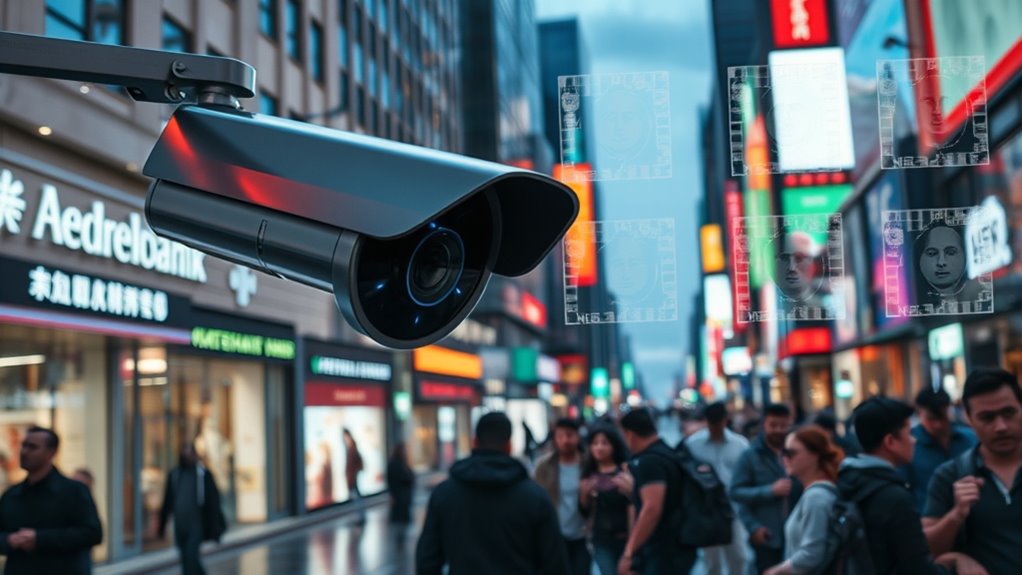
The rapid expansion of facial recognition technology is fueling impressive growth in the market and driving technological innovations. The global facial recognition market was worth $6.94 billion in 2024 and is expected to reach $7.92 billion in 2025, with a 14.2% annual growth rate. By 2032, projections estimate the market will hit $19.3 billion. North America leads the sector with a 43.1% share, thanks to continuous investments and advances. Enhanced AI integration has improved detection accuracy to over 99.5%, enabling wider applications across security, finance, and public services. These technological advancements make facial recognition more reliable and versatile, fueling further market expansion and innovation in the coming years. Additionally, advancements in crochet styles for locs are inspiring creative approaches to personal expression and style. As these developments progress, it is important to consider the importance of privacy concerns in maintaining public trust and safeguarding individual rights, especially as data security measures become more critical in the deployment of facial recognition systems. Furthermore, ongoing research into personality assessment tools can help improve user experience and ethical standards in AI applications. Moreover, the integration of public awareness initiatives is vital to ensure transparency and accountability in facial recognition deployment.
Enhancing Security and Law Enforcement Capabilities

Facial recognition technology markedly boosts crime-solving efficiency by quickly identifying suspects and missing persons. Real-time monitoring allows law enforcement to respond faster to threats and track criminal activity as it happens. By leveraging these capabilities, authorities can enhance public safety and streamline investigations more effectively. Incorporating advanced dog names can also improve communication and identification in search and rescue operations. Additionally, understanding the importance of father-daughter bond can foster community trust and cooperation in security initiatives. Emphasizing ethical hacking principles ensures that the deployment of such surveillance technologies adheres to privacy standards and mitigates potential misuse. Recognizing the diverse genres of media can further promote responsible use of surveillance in various community contexts. Proper training in privacy protocols is essential to balance security benefits with individual rights and prevent misuse of surveillance data.
Crime Solving Efficiency
Advancements in facial recognition technology have considerably boosted the ability of law enforcement agencies to solve crimes more efficiently. You can now identify suspects faster by analyzing images from crime scenes, surveillance footage, or public cameras. This technology reduces the time spent on manual investigations and increases the likelihood of catching offenders. For example, police departments across the globe use facial recognition to match suspects with existing criminal databases, streamlining identification processes. It also helps locate missing persons by quickly scanning large crowds or public spaces. additionally, AI-enhanced facial recognition improves accuracy and decreases false positives, making investigations more reliable. Overall, this technology accelerates crime resolution, enhances public safety, and supports law enforcement in addressing complex cases more effectively.
Real-Time Monitoring Benefits
Real-time monitoring with facial recognition technology substantially boosts security and law enforcement efforts by enabling immediate identification of individuals in public spaces. This rapid identification helps authorities prevent crimes before they happen, respond swiftly to threats, and track suspects in crowded areas. For example, law enforcement agencies can instantly match faces against watchlists, catching wanted criminals or missing persons in real time. Airports and transit stations use live recognition to enhance passenger security, reducing wait times and deterring illegal activities. By continuously analyzing footage, authorities gain a proactive tool that increases safety and mitigates risks more effectively than traditional methods. This technology allows for swift responses, improved resource allocation, and heightened situational awareness, making public spaces safer for everyone.
Privacy Risks and Ethical Dilemmas

You should consider how data gathering often happens without clear transparency or public consent, raising questions about who controls your personal information. The risk of misuse is real when facial recognition data is exploited for purposes beyond its original intent, like targeted advertising or social monitoring. As AI advances, balancing security benefits with respect for privacy becomes a vital ethical challenge. Additionally, the deployment of facial recognition technology in various sectors often involves internal company hackathons, which can be opportunities to develop more ethical and privacy-conscious solutions. Furthermore, understanding the role of creative practice in designing ethical AI systems highlights the importance of innovation and resilience in addressing these complex issues. Recognizing the importance of regulatory compliance can help ensure that these technologies are developed and used responsibly. Moreover, ongoing discussions about cybersecurity vulnerabilities underscore the necessity of implementing comprehensive safeguards to protect personal data from potential breaches. Ensuring data security is essential to maintain public trust and prevent malicious exploitation of sensitive information.
Data Gathering Transparency
Despite the widespread adoption of facial recognition technology, many organizations and governments lack transparency about how they gather and use this data. You often don’t know where your images are stored, who has access, or how long they keep it. This opaque process raises privacy risks and ethical dilemmas. For example:
- Data collection occurs without clear consent or notification.
- Governments and private companies access vast face databases secretly.
- Data is shared across jurisdictions without user awareness.
- Retention policies are unclear, and data may be stored indefinitely.
- The use of Cookies can track user interactions and potentially contribute to data profiling without explicit consent.
This lack of transparency makes it difficult for you to understand how your biometric information is used or protected. It fuels distrust, increases the risk of misuse, and hampers efforts to hold organizations accountable for privacy violations.
Potential for Misuse
The lack of transparency in how facial recognition data is collected and stored opens the door to significant misuse. You might not realize that data can be used beyond its original purpose, such as targeted advertising, political profiling, or even social control. Governments and private entities can manipulate this information to monitor specific groups, suppress dissent, or unjustly target individuals. Without strict oversight, data breaches and unauthorized sharing expose you to identity theft and privacy violations. Ethical dilemmas arise when facial recognition is deployed without consent or safeguards, risking discrimination against vulnerable populations. As technology advances rapidly, the potential for misuse grows, emphasizing the urgent need for clear regulations and safeguards to protect your rights and prevent abuse. Additionally, the security of encryption used to safeguard stored facial data is crucial to prevent unauthorized access and maintain user trust. Implementing transparent policies regarding data collection and usage can help mitigate some of these concerns. Moreover, establishing standards for data accuracy and fairness is essential to prevent biases and inaccuracies that could harm certain groups. Recognizing the importance of public awareness can also empower individuals to understand and advocate for responsible AI usage and privacy protections.
Public Perception and Acceptance of Facial Recognition
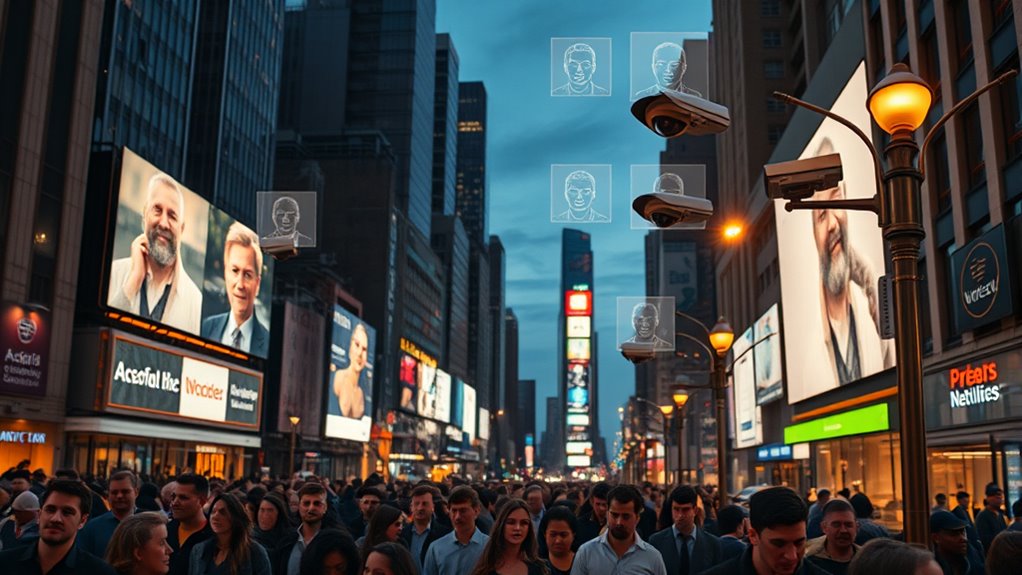
Public perception of facial recognition varies widely, shaped by concerns over privacy, security, and civil liberties. Many people see its benefits for safety and crime prevention, but others worry about mass surveillance and misuse. You might notice that:
Public views on facial recognition are mixed, balancing safety benefits against privacy concerns and civil liberties.
- Some support its use in law enforcement and public safety initiatives.
- Others oppose it, citing fears of constant monitoring and loss of anonymity.
- Public trust fluctuates depending on transparency and regulation.
- Acceptance tends to be higher when used with clear consent and oversight.
Regulatory Landscape and Legal Challenges
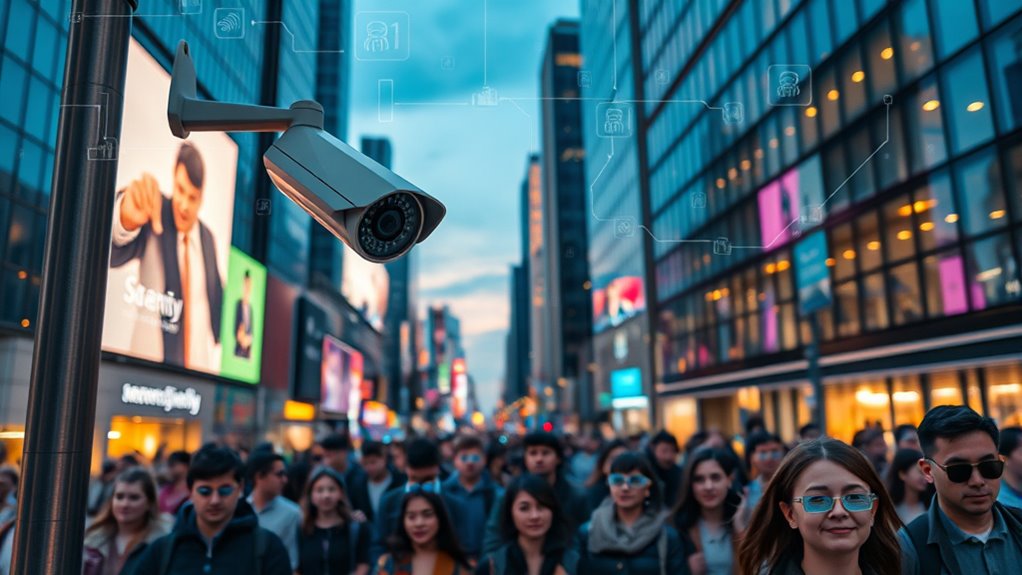
Regulatory efforts surrounding facial recognition technology are struggling to keep pace with its rapid growth and widespread adoption. Many countries lack comprehensive laws, leaving a legal void that often favors deployment over privacy protection. Some nations, like Belgium and Luxembourg, have implemented outright bans, but most jurisdictions rely on vague regulations or industry guidelines. The European Union’s AI Act aims to restrict certain uses but faces criticism for insufficient safeguards, especially for vulnerable groups. In the US, regulations are patchy, with states adopting different standards. Lawmakers grapple with balancing technological innovation, public safety, and privacy rights. This legal uncertainty fuels concerns about misuse, discrimination, and mass surveillance, highlighting the urgent need for all-encompassing, enforceable policies that can keep pace with technological advances.
Surveillance in Public Spaces and Private Sectors
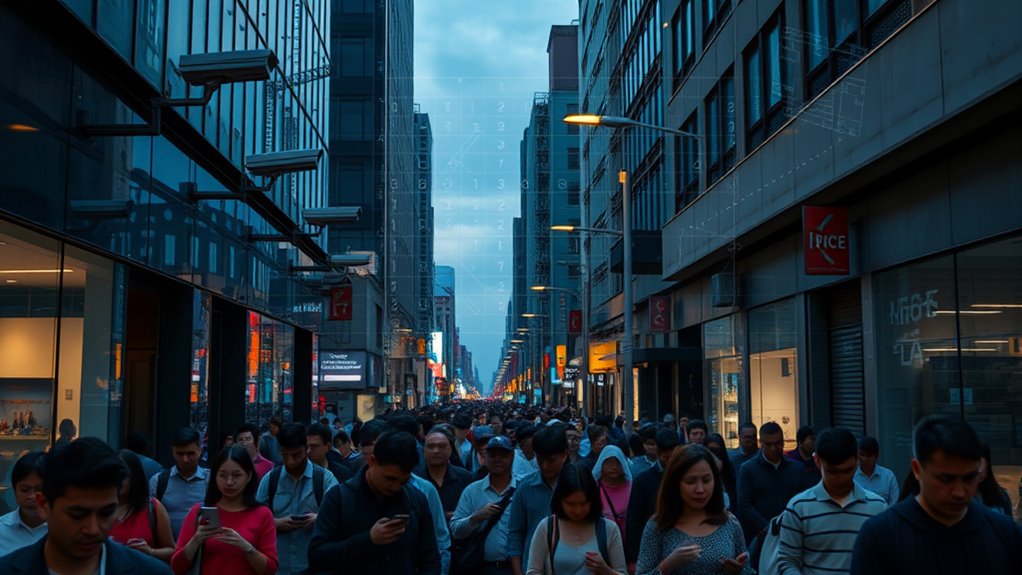
Surveillance in public spaces and private sectors has expanded rapidly as facial recognition technology becomes more embedded in daily life. You might notice cameras at airports, train stations, or even in stores and workplaces, constantly scanning faces. This widespread use includes:
Facial recognition surveillance is expanding rapidly in public and private spaces.
- Airports with facial recognition at security checkpoints and boarding gates
- Public transit systems employing facial scans on buses and trains
- Shopping malls and retail stores monitoring customer movements
- Corporate offices using biometric access controls for employees
These deployments aim to enhance security and efficiency but often operate with little public awareness or consent. As technology advances, your presence is increasingly tracked and analyzed in various environments. While some see it as a safety upgrade, others worry about the erosion of privacy and the potential for misuse.
Impact on Human Rights and Civil Liberties

As facial recognition technology becomes more embedded in public and private spaces, its deployment raises serious concerns about human rights and civil liberties. You may feel your privacy is compromised when cameras track your every move without consent. This can lead to chilling effects, discouraging free expression and assembly. False matches and biases often target vulnerable groups, risking wrongful detention or discrimination. The pervasive surveillance erodes anonymity and can suppress dissent. Below is a table highlighting some key impacts:
| Negative Impact | Explanation |
|---|---|
| Privacy infringement | Loss of control over personal data |
| Discrimination | Biases target minorities and vulnerable groups |
| Chilling effects | Fear inhibits free speech and protests |
| Wrongful accusations | Inaccurate matches lead to unjust consequences |
| Loss of anonymity | Reduced ability to move freely without profiling |
Balancing Innovation With Privacy Protections
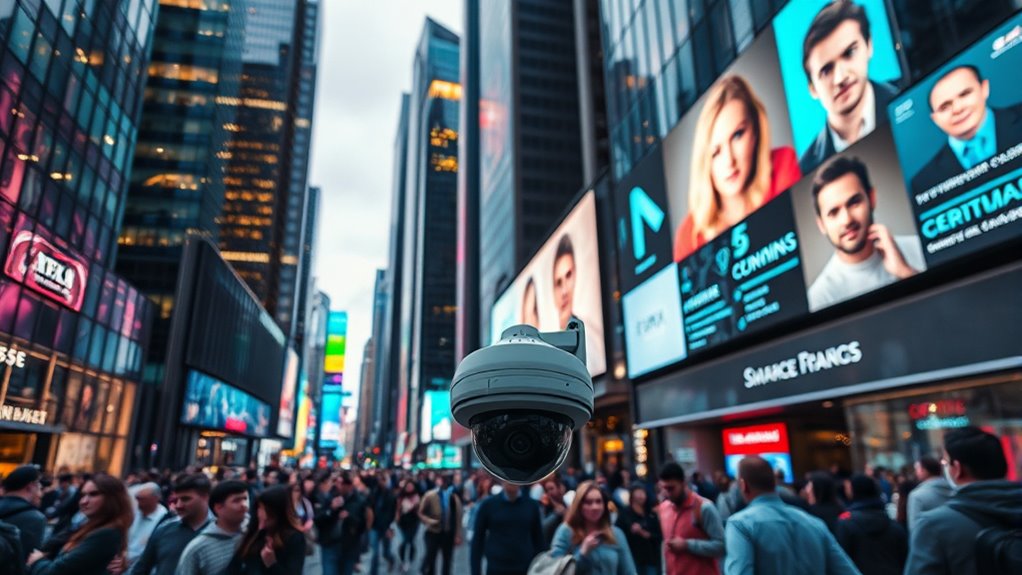
Balancing innovation with privacy protections is vital as facial recognition technology becomes more widespread. You need safeguards that foster progress without sacrificing individual rights. Consider implementing transparent policies that define clear use cases and limit data collection. Regular audits can ensure compliance and prevent misuse. Public engagement helps build trust, so involving communities in decision-making is essential. Technical measures like encryption, anonymization, and strict access controls protect data integrity. Additionally, establishing legal frameworks that balance security with privacy rights offers clarity and accountability.
Safeguard facial recognition with transparent policies, regular audits, community involvement, and strong legal and technical protections.
- Clear consent protocols for users
- Limitations on data retention periods
- Oversight bodies to monitor deployment
- Penalties for misuse or violations
The Future of Surveillance and Responsible AI Use

The future of surveillance and responsible AI use hinges on developing frameworks that guarantee technological advancements serve society without compromising individual rights. You need regulations that keep pace with evolving facial recognition tech, ensuring transparency and accountability. As AI improves accuracy and expands applications, safeguards must prevent misuse, such as unwarranted mass surveillance or privacy breaches. Public trust depends on clear policies that limit intrusive practices and protect vulnerable groups. Governments and industries must collaborate to create ethical standards, enforce oversight, and promote responsible innovation. You should advocate for balanced approaches that harness AI’s benefits—like enhanced security and efficiency—while respecting privacy. By establishing responsible guidelines now, you help shape a future where surveillance technology supports society without eroding personal freedoms.
Frequently Asked Questions
How Secure Is Facial Recognition Data From Hacking or Misuse?
Facial recognition data’s security varies, but it’s generally vulnerable to hacking and misuse. Cybercriminals can exploit weak encryption or storage flaws to access sensitive info. If you’re using facial recognition for unlocking devices or in financial transactions, you should guarantee the systems employ robust security measures like advanced encryption and multi-factor authentication. Stay aware of privacy policies and updates to minimize risks and protect your biometric data from misuse.
Can Facial Recognition Technology Be Biased or Discriminatory?
You might be surprised to learn that facial recognition technology isn’t perfect—its accuracy can drop markedly for certain groups. Studies show it’s less accurate for women and people of color, leading to biased or discriminatory outcomes. This bias stems from limited diverse data during training and algorithm flaws. So, yes, facial recognition can be biased, which raises concerns about fairness and equal treatment in its applications.
What Are the Legal Rights of Individuals Regarding Facial Recognition Data?
Your legal rights regarding facial recognition data vary depending on where you are. In some regions, like the EU, laws give you control over your biometric data, requiring consent for collection and use. In others, regulations are still catching up, leaving you with limited protections. You can often request access, correction, or deletion of your data, but enforcement and scope differ widely, so staying informed about local laws is vital.
How Do Governments Justify Widespread Facial Recognition Deployment?
Governments justify widespread facial recognition deployment by emphasizing public safety, crime prevention, and efficient law enforcement. They argue that it helps solve crimes faster, secures borders, and improves public services. Many believe it’s a necessary tool for modern security infrastructure. However, they often overlook privacy concerns, framing these technologies as essential for national security and progress, even as debates over rights and oversight continue.
What Measures Exist to Prevent Unauthorized Surveillance and Privacy Violations?
You might think strict laws prevent misuse, but often, they lag behind technology. To safeguard against unauthorized surveillance, some countries implement regulations requiring oversight, transparency, and public consent. Others establish data protection standards and restrict access to facial recognition data. Still, enforcement varies. You can advocate for stronger legal frameworks, demand transparency from authorities, and support privacy rights organizations to hold governments accountable and ensure your privacy isn’t compromised.
Conclusion
As facial recognition technology continues to evolve, the line between security and privacy blurs, leaving you to wonder what’s truly at stake. Will society find a way to harness innovation responsibly, or will these advancements threaten your civil liberties in ways you can’t yet imagine? The future remains uncertain, but one thing’s clear: how we choose to navigate these developments now will shape the balance of power and privacy for generations to come.










